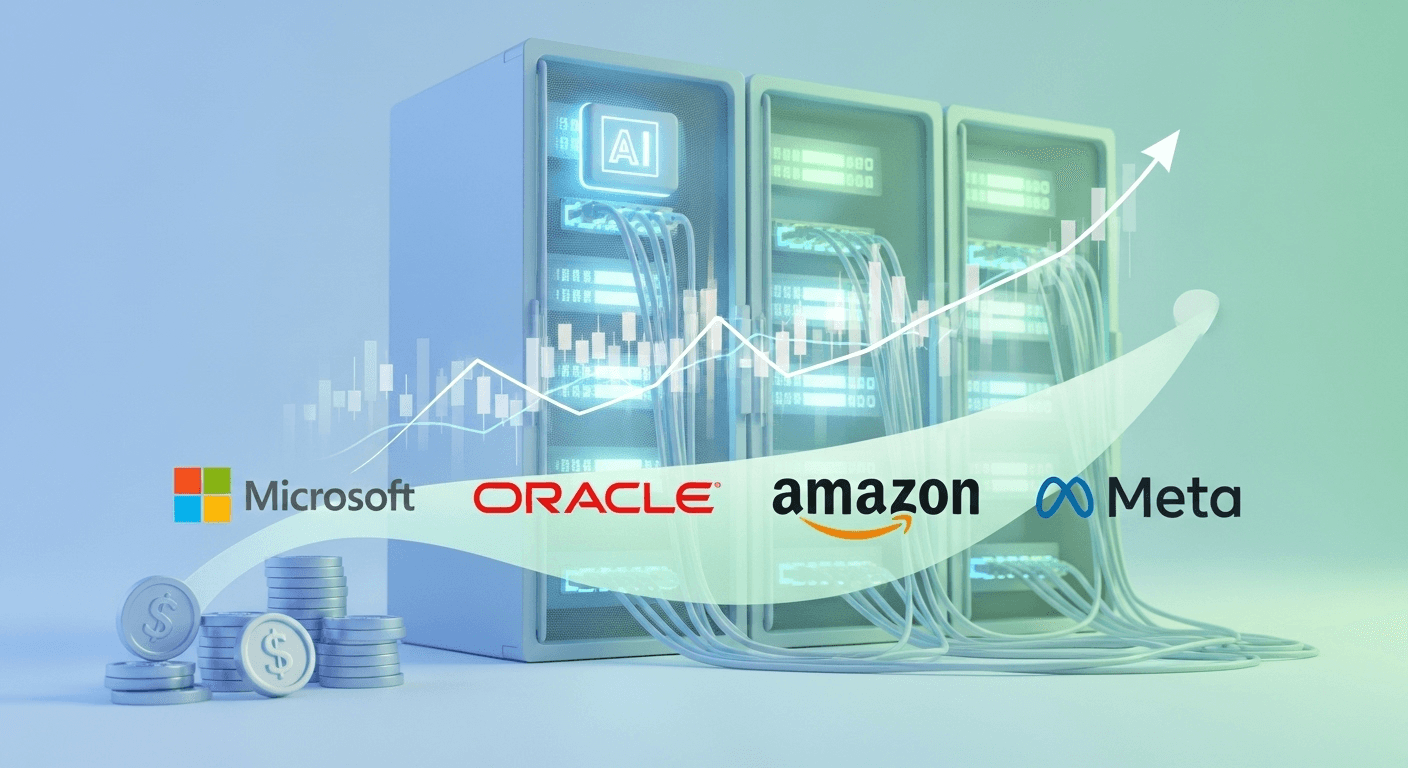The AI Buildout: How Finance Leases Are Accelerating Microsoft and Oracle’s Investments

Summary
The investment in AI infrastructure by tech giants such as Microsoft, Oracle, Amazon, and Meta is significantly greater than what traditional capital expenditure (capex) figures indicate. A key contributor to this is the utilization of finance leases. These long-term lease agreements allow companies to include data centers, servers, and networking equipment on their balance sheets without requiring upfront cash, thereby creating a more favorable impression of free cash flow in the short term, all while actual investment escalates. This overview delves into the details of this trend, its implications, and how to interpret these figures in financial reports.
- Microsoft saw its finance lease liabilities surge to approximately $46.2 billion in fiscal 2025, with an astonishing $92.7 billion in additional leases not yet started, primarily related to data centers.
- Oracle went from virtually no finance leases to around $4.0 billion by August 2025, also revealing $43.4 billion in forthcoming lease commitments.
- Analysts incorporating finance leases into their capex calculations find that Microsoft’s capex-to-sales ratio skyrockets to 38% and Oracle’s reaches 58% when these leases are accounted for.
- Amazon, which traditionally preferred asset ownership, saw a significant uptick in equipment funded through finance leases, recording $937 million of such acquisitions in Q2 2025, a leap from $181 million the previous year.
- Meta reported $52.56 billion in leases yet to begin, mainly for data centers, indicating future expansion plans.
In subsequent sections, we will explore the mechanics of finance leases, analyze each company’s figures, and provide a straightforward checklist for investors and stakeholders.
The Engine Behind the Growth: Finance Leases Explained
Under U.S. GAAP’s ASC 842, leases can be designated as finance leases when they effectively transfer most ownership risks and rewards to the lessee. Essentially, this mimics purchasing an asset via debt, even if the legal title remains with the lessor. Initially, firms recognize both a right-of-use asset and a lease liability. Over time, lease payments reduce the liability, while interest and amortization are recorded based on the lease terms.
Why This Matters:
- No Immediate Cash Flow Impact: At the start of a finance lease, companies do not incur immediate cash outflows as they would with a cash purchase. This temporarily boosts free cash flow as investments ramp up.
- Differentiation in Cash Flows: Principal repayments on finance leases are classified within financing cash flows instead of operating or investing cash flows, reinforcing the impression of healthy free cash flow despite significant capital investments. Some organizations also report adjusted free cash flow metrics excluding these payments.
- Increased Balance Sheets and Fixed Charges: The liabilities from leases add to the total financial obligations and future cash commitments, critical factors in assessing creditworthiness, capital allocation, and risk management.
In summary, finance leases facilitate rapid scaling of AI infrastructure while presenting a favorable near-term cash flow profile. However, they entail substantial obligations that resemble debt commitments.
Microsoft: Massive Lease Liabilities and a Robust Pipeline
According to Microsoft’s 2025 10-K filing, finance lease liabilities amounted to $46.172 billion by June 30, 2025, a significant increase over the prior year. Additionally, the company disclosed an impressive $92.7 billion in leases that have been signed but have yet to commence, primarily associated with data centers, with terms spanning up to 20 years.
Why This Is Significant
Analysts are increasingly adjusting investment intensity calculations to include assets funded through leases. Morgan Stanley’s methodology, referenced by MarketWatch, suggests that when finance leases are factored in, Microsoft’s capex-to-sales ratio rises to 38% compared to 28% when looking solely at traditional capex.
Key Takeaway
Microsoft’s genuine AI infrastructure buildout far exceeds what traditional cash capex figures suggest. The newly contracted leases indicate a long duration of spending that will eventually impact income statements and cash flows.
Oracle: Rapid Growth in Lease Financing
Oracle’s financial disclosures reveal a swift adoption of finance leases to scale its AI infrastructure:
– Finance lease liabilities climbed to $2.934 billion as of May 31, 2025, with a marked increase to $4.017 billion by August 31, 2025.
– Additionally, Oracle has announced $43.4 billion in uncommenced lease obligations, mostly for data centers.
To support its expansion strategy, Oracle capitalized on bond markets, issuing $18 billion in investment-grade debt in late September 2025, marking one of the largest corporate debt deals of the year.
Analysts incorporating leases into Oracle’s capex measurements indicate a capital expenditure-to-sales ratio soaring to 58%, evidencing the company’s aggressive approach to expanding its AI infrastructure.
Context
Reports indicate that Oracle has entered into a multiyear cloud agreement with OpenAI, potentially totaling hundreds of billions of dollars in computing resources over about five years starting in 2027. Such partnerships underscore Oracle’s reliance on leases and debt for financing.
Implications
Finance leases enable Oracle to rapidly increase capacity without incurring immediate cash expenditures, but they also create significant obligations alongside new bond debts. Investors will need to closely monitor asset utilization and pricing dynamics to assess earnings against these commitments.
Amazon and Meta: Big Tech’s Trend Towards Finance Leases
Amazon historically balanced owned and leased assets. However, there’s been a notable shift in 2025 towards increased usage of finance leases for AI-related equipment. In Q2 2025, Amazon reported $937 million of property acquired via finance leases, compared to $181 million in Q2 2024.
Meta’s filings for 2025 reveal future expansions linked to leases. By June 30, 2025, Meta reported $52.56 billion in operating and finance leases not yet initiated, primarily for data centers and networking.
Why This Accounting Detail Matters
1. Free Cash Flow Visibility vs. Obligations
Finance leases, lacking upfront cash requirements, can make free cash flow appear robust even as companies invest heavily in lease-backed assets. While principal and interest payments will need to be made over time, their accounting treatment differs from cash purchases, which is why some firms present an adjusted free cash flow metric that omits principal lease payments.
2. Understated Capex Intensity Without Leases
Traditional capex figures often overlook the assets acquired via finance leases. Analysts merging cash capex with finance lease liabilities typically find investment cycles more intense than cash capex figures imply. For instance, Microsoft’s ratio of capex to sales increases dramatically when leases are factored in.
3. Credit Risk Considerations
Leases are perceived similarly to debt by rating agencies and investors. An increase in lease obligations and lengthier terms can heighten financial risks, especially if market demand or pricing fails to meet expectations. Oracle’s commitment to bonds and rising leases exemplify this combination of leveraged financing for large-scale buildouts.
4. Growing Interconnectivity of the Ecosystem
Recent 2025 deals illustrate a tight network of obligations among AI developers, GPU manufacturers, cloud providers, and specialized AI infrastructure firms. Circular financing trends are emerging as investment flows among related parties via equity stakes and long-term agreements, raising concerns about the sustainability of reported growth metrics.
Key Points to Monitor in Financial Filings
To evaluate AI infrastructure investments beyond the surface-level capex figures, consider this checklist:
– Finance Lease Liabilities and Maturities: Review the lease liabilities schedule and payment timelines, such as Microsoft’s disclosures regarding both existing and future liabilities.
– Uncommenced Leases: These signals indicate upcoming asset and expense growth. Notable figures include Microsoft’s $92.7 billion, Oracle’s $43.4 billion, and Meta’s $52.56 billion.
– Supplementary Cash Flow Statements: Look for lines representing property acquired via finance leases and principal finance lease repayments, similar to Amazon’s detailed disclosures in their Q2 2025 report.
– Lease Classification and Useful Life Footnotes: Changes in estimated useful lives for infrastructure can significantly influence depreciation and earnings, while lease classification may adjust expense timing.
The Bigger Picture: Continued Growth in Spending
Independent forecasts anticipate substantial future AI infrastructure expenditures. Analysts at Citi recently projected that investments by hyperscalers could near $490 billion by 2026, a rise from prior estimates. This trajectory suggests that a combination of cash capex, leases, and debt financing will remain essential.
Additionally, new multi-billion-dollar cloud capacity agreements point to how the exposure of individual customers can expand significantly. Recent reports have highlighted multiyear, billion-dollar infrastructure agreements between companies like CoreWeave, Meta, OpenAI, and Nvidia, weaving a complex financial ecosystem.
Company Snapshots
Microsoft
- Finance Lease Liabilities: $46.172 billion as of June 30, 2025.
- Uncommenced Leases: $92.7 billion, primarily related to data centers, set to commence between 2026 and 2031.
- Adjusted Capex-to-Sales Ratio: 38% with finance leases, based on Morgan Stanley analysis.
Watch for: The timing of lease commencements, interest on finance leases, and the balance between owned and leased capacities as Microsoft expands AI services.
Oracle
- Finance Lease Liabilities: Increased from $2.934 billion as of May 31, 2025, to $4.017 billion by August 31, 2025.
- Uncommenced Leases: $43.4 billion as of May 31, 2025.
- Bond Issuance: $18 billion of investment-grade notes issued in September 2025.
- Adjusted Capex-to-Sales Ratio: Climbs to 58% when finance leases are included.
Watch for: Utilization rates of new capacities, customer concentration on major AI contracts, and the fabric of lease versus debt financing.
Amazon
- Finance Lease Trend: $937 million in property and equipment funded by finance leases in Q2 2025, up from $181 million a year earlier.
- Lease Liabilities: Ascending operating and finance lease liabilities as of June 30, 2025, with comprehensive schedules included in the 10-Q filing.
Watch for: How Amazon balances owned against leased GPU capacity in AWS, and whether finance lease usage continues to rise alongside AI demand.
Meta
- Uncommenced Leases: $52.56 billion as of June 30, 2025, primarily earmarked for data centers and networking.
Watch for: The timeline for lease commencements, energy procurement for new data centers, and efficiency gains as AI services scale.
Interpreting Capex, Leases, and Free Cash Flow
A straightforward framework to ensure proper analysis during an AI buildout involves:
1. Start with the GAAP free cash flow as reported by the company.
2. Add back additions of finance lease-funded assets or note the year-over-year increase in finance lease liabilities.
3. Deduct principal payments on finance leases to grasp cash obligations often absent from operating or investing cash flows.
4. Compare overall investment growth to revenue and gross profit enhancements. A rising capex intensity, factoring in leases, against stagnant monetization suggests growing risks.
Risks and Outstanding Issues
- Power and Supply Shortages: Even with financing secured, availability of power and equipment can hinder projects, extending timelines for those still in the “not yet commenced” phase.
- Customer Concentration Risks: Large single-customer contracts can inflate reported commitments, while also heightening concentration risk.
- Circular Financing Concerns: Interlinked equity investments, prepayments, lease agreements, and long-term purchase obligations among associated parties can obscure true economic conditions.
- Interest Rate Vulnerability: Many finance leases and bonds have long durations. Rising interest rates can impose higher costs on capacity expansion and alter acceptable return thresholds.
Conclusion
AI infrastructure spending is vastly larger than it may initially seem when solely tracking cash capex. Finance leases have emerged as a crucial strategy for hyperscalers and others to quickly augment capacity while delaying immediate cash requirements. Consequently, capex intensity is soaring, especially at Microsoft and Oracle, with Amazon and Meta also capitalizing on this trend. Investors and stakeholders should engage closely with lease footnotes and supplemental cash flow tables to uncover the true scale of this development.
Thank You for Reading this Blog and See You Soon! 🙏 👋
Let's connect 🚀
Latest Blogs
Read My Latest Blogs about AI

Inside OpenAI’s Custom Chip Leap: The Broadcom Deal, 10GW of Compute, and Its Implications for AI
OpenAI and Broadcom announce a partnership to develop 10GW of custom AI chips starting in 2026. Discover how this reshapes costs, performance, and supply for AI infrastructure.
Read more


